HA3011 Advanced Financial Accounting Assignment, Holmes Institute
VerifiedAdded on 2023/03/30
|11
|2771
|255
Homework Assignment
AI Summary
This assignment analyzes the advanced financial accounting practices of Abacus Property Group, focusing on accounting concepts, fair value measurement, and qualitative features of financial statements. It discusses the company's application of accounting judgments, estimates, and assumptions in valuing assets and liabilities. The assignment highlights the use of fair value, its impact on financial reporting, and the challenges associated with market fluctuations. It also covers impairment of goodwill, intangibles, and financial assets, as well as valuation of investment properties and equipment. The document emphasizes the importance of management judgments and assumptions in determining fair values and their potential impact on financial outcomes. Furthermore, it explores the issue of fair value measurement, its influence on market dynamics, and the reliability of fair value accounting compared to historical costs. Overall, the assignment provides insights into the complexities of financial accounting and the application of accounting standards.
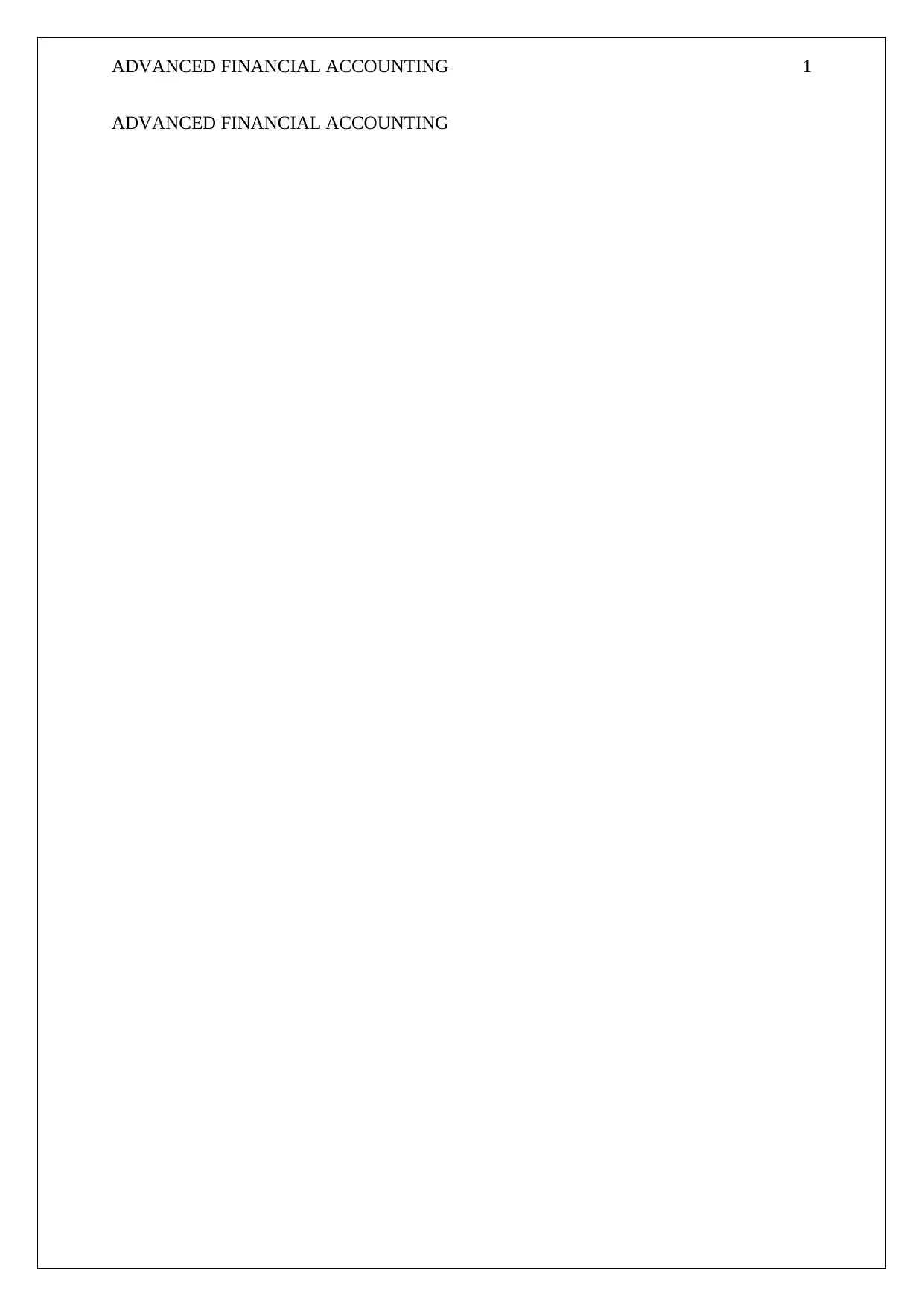
ADVANCED FINANCIAL ACCOUNTING 1
ADVANCED FINANCIAL ACCOUNTING
ADVANCED FINANCIAL ACCOUNTING
Paraphrase This Document
Need a fresh take? Get an instant paraphrase of this document with our AI Paraphraser
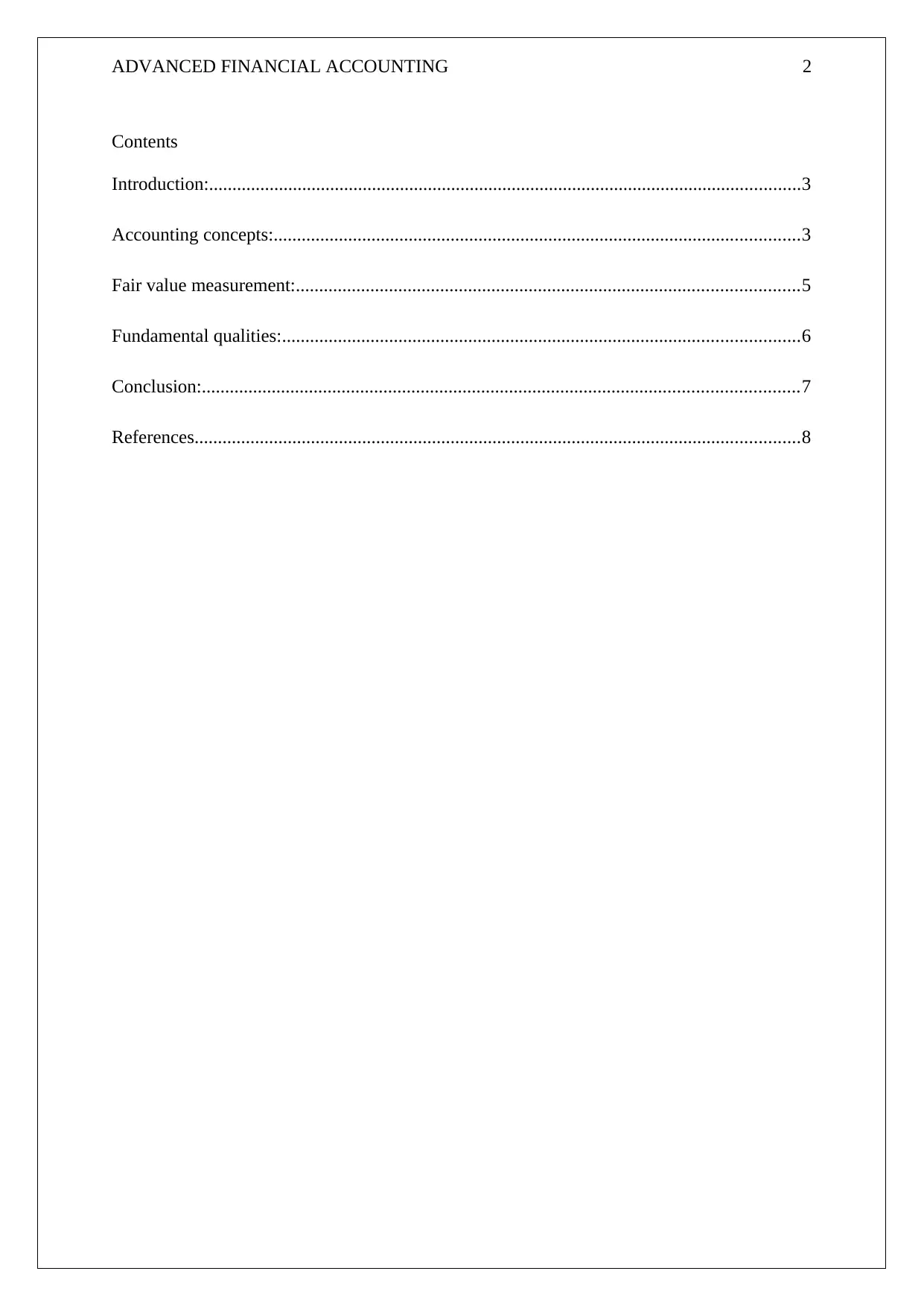
ADVANCED FINANCIAL ACCOUNTING 2
Contents
Introduction:...............................................................................................................................3
Accounting concepts:.................................................................................................................3
Fair value measurement:............................................................................................................5
Fundamental qualities:...............................................................................................................6
Conclusion:................................................................................................................................7
References..................................................................................................................................8
Contents
Introduction:...............................................................................................................................3
Accounting concepts:.................................................................................................................3
Fair value measurement:............................................................................................................5
Fundamental qualities:...............................................................................................................6
Conclusion:................................................................................................................................7
References..................................................................................................................................8
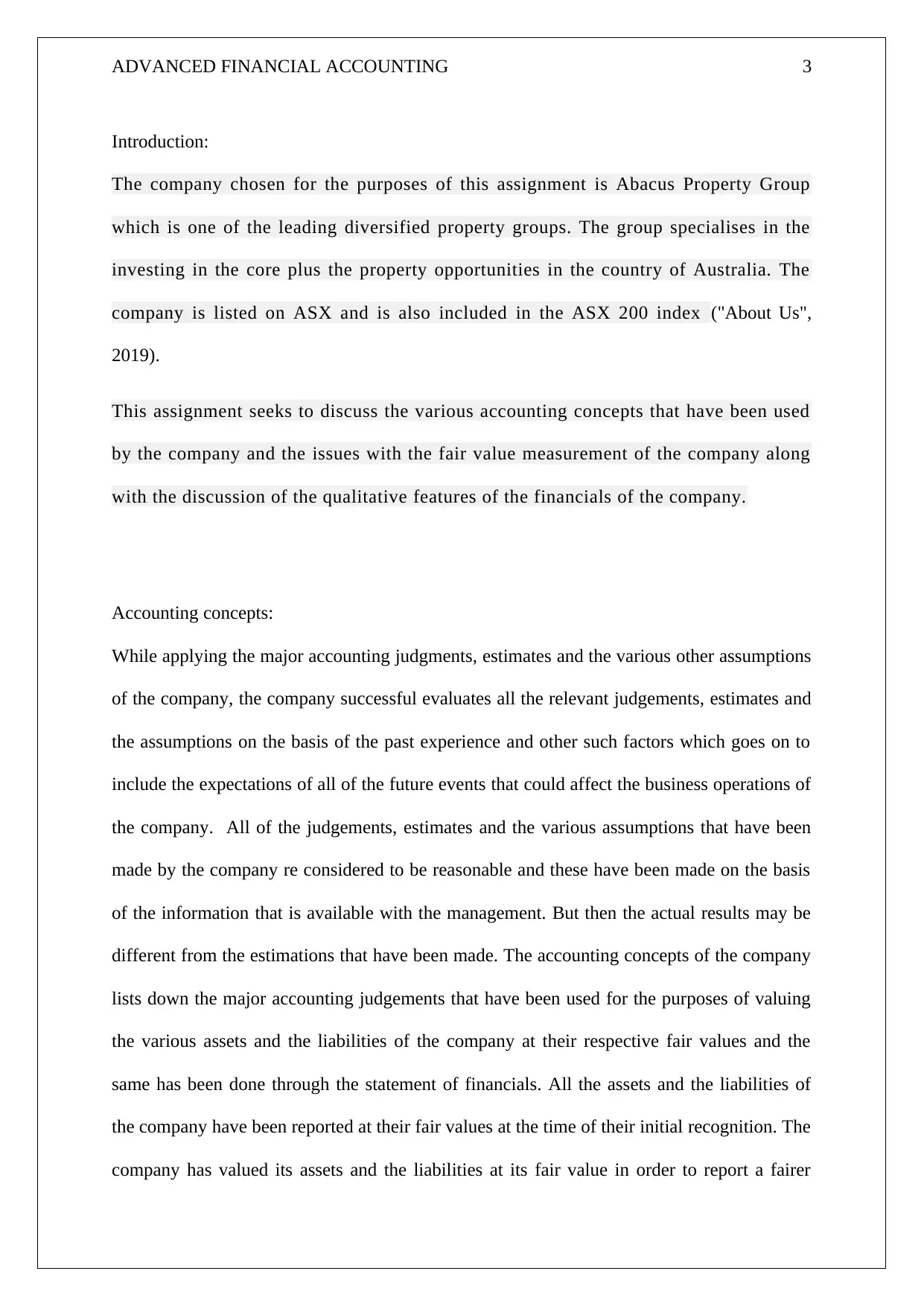
ADVANCED FINANCIAL ACCOUNTING 3
Introduction:
The company chosen for the purposes of this assignment is Abacus Property Group
which is one of the leading diversified property groups. The group specialises in the
investing in the core plus the property opportunities in the country of Australia. The
company is listed on ASX and is also included in the ASX 200 index ("About Us",
2019).
This assignment seeks to discuss the various accounting concepts that have been used
by the company and the issues with the fair value measurement of the company along
with the discussion of the qualitative features of the financials of the company.
Accounting concepts:
While applying the major accounting judgments, estimates and the various other assumptions
of the company, the company successful evaluates all the relevant judgements, estimates and
the assumptions on the basis of the past experience and other such factors which goes on to
include the expectations of all of the future events that could affect the business operations of
the company. All of the judgements, estimates and the various assumptions that have been
made by the company re considered to be reasonable and these have been made on the basis
of the information that is available with the management. But then the actual results may be
different from the estimations that have been made. The accounting concepts of the company
lists down the major accounting judgements that have been used for the purposes of valuing
the various assets and the liabilities of the company at their respective fair values and the
same has been done through the statement of financials. All the assets and the liabilities of
the company have been reported at their fair values at the time of their initial recognition. The
company has valued its assets and the liabilities at its fair value in order to report a fairer
Introduction:
The company chosen for the purposes of this assignment is Abacus Property Group
which is one of the leading diversified property groups. The group specialises in the
investing in the core plus the property opportunities in the country of Australia. The
company is listed on ASX and is also included in the ASX 200 index ("About Us",
2019).
This assignment seeks to discuss the various accounting concepts that have been used
by the company and the issues with the fair value measurement of the company along
with the discussion of the qualitative features of the financials of the company.
Accounting concepts:
While applying the major accounting judgments, estimates and the various other assumptions
of the company, the company successful evaluates all the relevant judgements, estimates and
the assumptions on the basis of the past experience and other such factors which goes on to
include the expectations of all of the future events that could affect the business operations of
the company. All of the judgements, estimates and the various assumptions that have been
made by the company re considered to be reasonable and these have been made on the basis
of the information that is available with the management. But then the actual results may be
different from the estimations that have been made. The accounting concepts of the company
lists down the major accounting judgements that have been used for the purposes of valuing
the various assets and the liabilities of the company at their respective fair values and the
same has been done through the statement of financials. All the assets and the liabilities of
the company have been reported at their fair values at the time of their initial recognition. The
company has valued its assets and the liabilities at its fair value in order to report a fairer
⊘ This is a preview!⊘
Do you want full access?
Subscribe today to unlock all pages.

Trusted by 1+ million students worldwide
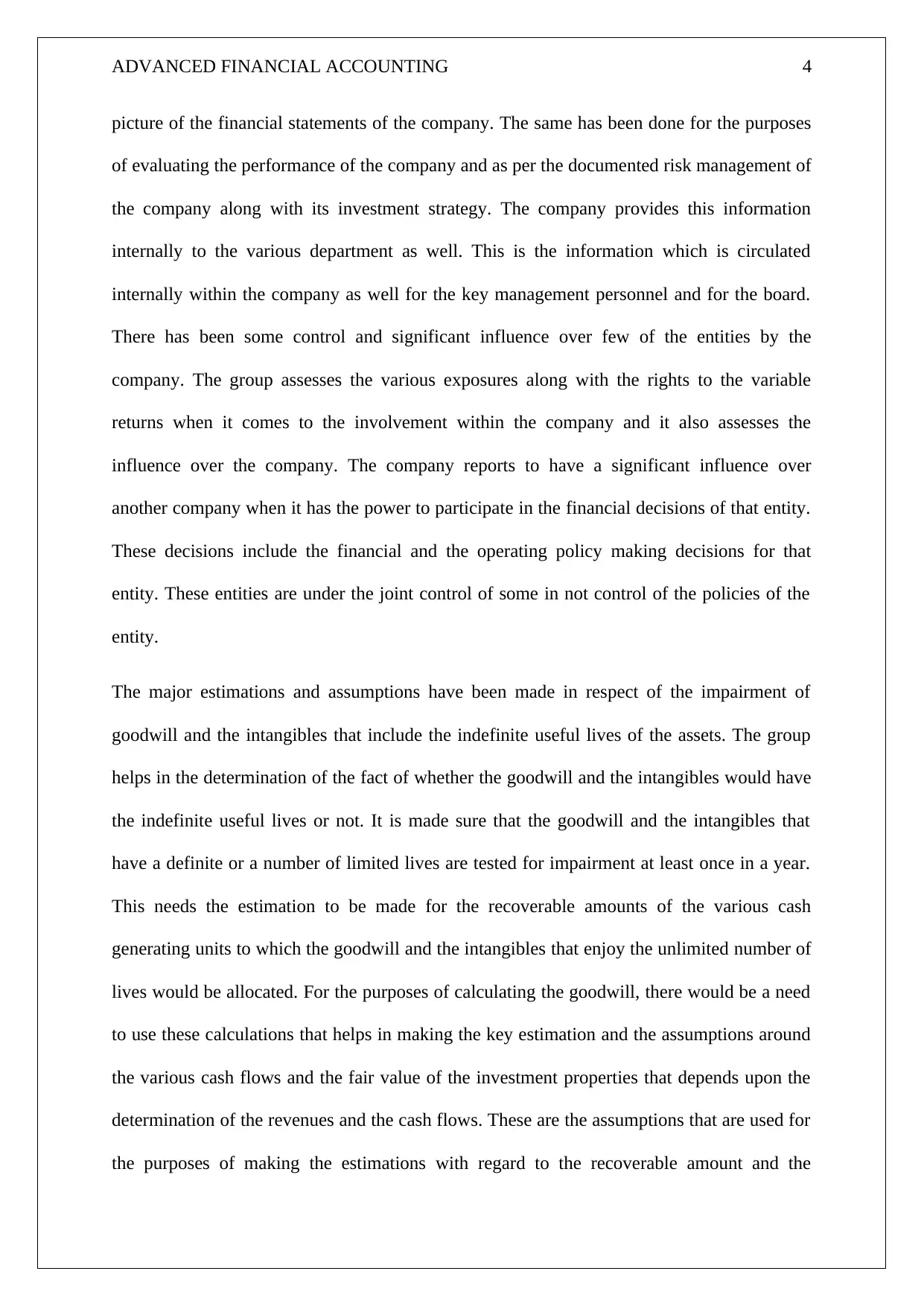
ADVANCED FINANCIAL ACCOUNTING 4
picture of the financial statements of the company. The same has been done for the purposes
of evaluating the performance of the company and as per the documented risk management of
the company along with its investment strategy. The company provides this information
internally to the various department as well. This is the information which is circulated
internally within the company as well for the key management personnel and for the board.
There has been some control and significant influence over few of the entities by the
company. The group assesses the various exposures along with the rights to the variable
returns when it comes to the involvement within the company and it also assesses the
influence over the company. The company reports to have a significant influence over
another company when it has the power to participate in the financial decisions of that entity.
These decisions include the financial and the operating policy making decisions for that
entity. These entities are under the joint control of some in not control of the policies of the
entity.
The major estimations and assumptions have been made in respect of the impairment of
goodwill and the intangibles that include the indefinite useful lives of the assets. The group
helps in the determination of the fact of whether the goodwill and the intangibles would have
the indefinite useful lives or not. It is made sure that the goodwill and the intangibles that
have a definite or a number of limited lives are tested for impairment at least once in a year.
This needs the estimation to be made for the recoverable amounts of the various cash
generating units to which the goodwill and the intangibles that enjoy the unlimited number of
lives would be allocated. For the purposes of calculating the goodwill, there would be a need
to use these calculations that helps in making the key estimation and the assumptions around
the various cash flows and the fair value of the investment properties that depends upon the
determination of the revenues and the cash flows. These are the assumptions that are used for
the purposes of making the estimations with regard to the recoverable amount and the
picture of the financial statements of the company. The same has been done for the purposes
of evaluating the performance of the company and as per the documented risk management of
the company along with its investment strategy. The company provides this information
internally to the various department as well. This is the information which is circulated
internally within the company as well for the key management personnel and for the board.
There has been some control and significant influence over few of the entities by the
company. The group assesses the various exposures along with the rights to the variable
returns when it comes to the involvement within the company and it also assesses the
influence over the company. The company reports to have a significant influence over
another company when it has the power to participate in the financial decisions of that entity.
These decisions include the financial and the operating policy making decisions for that
entity. These entities are under the joint control of some in not control of the policies of the
entity.
The major estimations and assumptions have been made in respect of the impairment of
goodwill and the intangibles that include the indefinite useful lives of the assets. The group
helps in the determination of the fact of whether the goodwill and the intangibles would have
the indefinite useful lives or not. It is made sure that the goodwill and the intangibles that
have a definite or a number of limited lives are tested for impairment at least once in a year.
This needs the estimation to be made for the recoverable amounts of the various cash
generating units to which the goodwill and the intangibles that enjoy the unlimited number of
lives would be allocated. For the purposes of calculating the goodwill, there would be a need
to use these calculations that helps in making the key estimation and the assumptions around
the various cash flows and the fair value of the investment properties that depends upon the
determination of the revenues and the cash flows. These are the assumptions that are used for
the purposes of making the estimations with regard to the recoverable amount and the
Paraphrase This Document
Need a fresh take? Get an instant paraphrase of this document with our AI Paraphraser
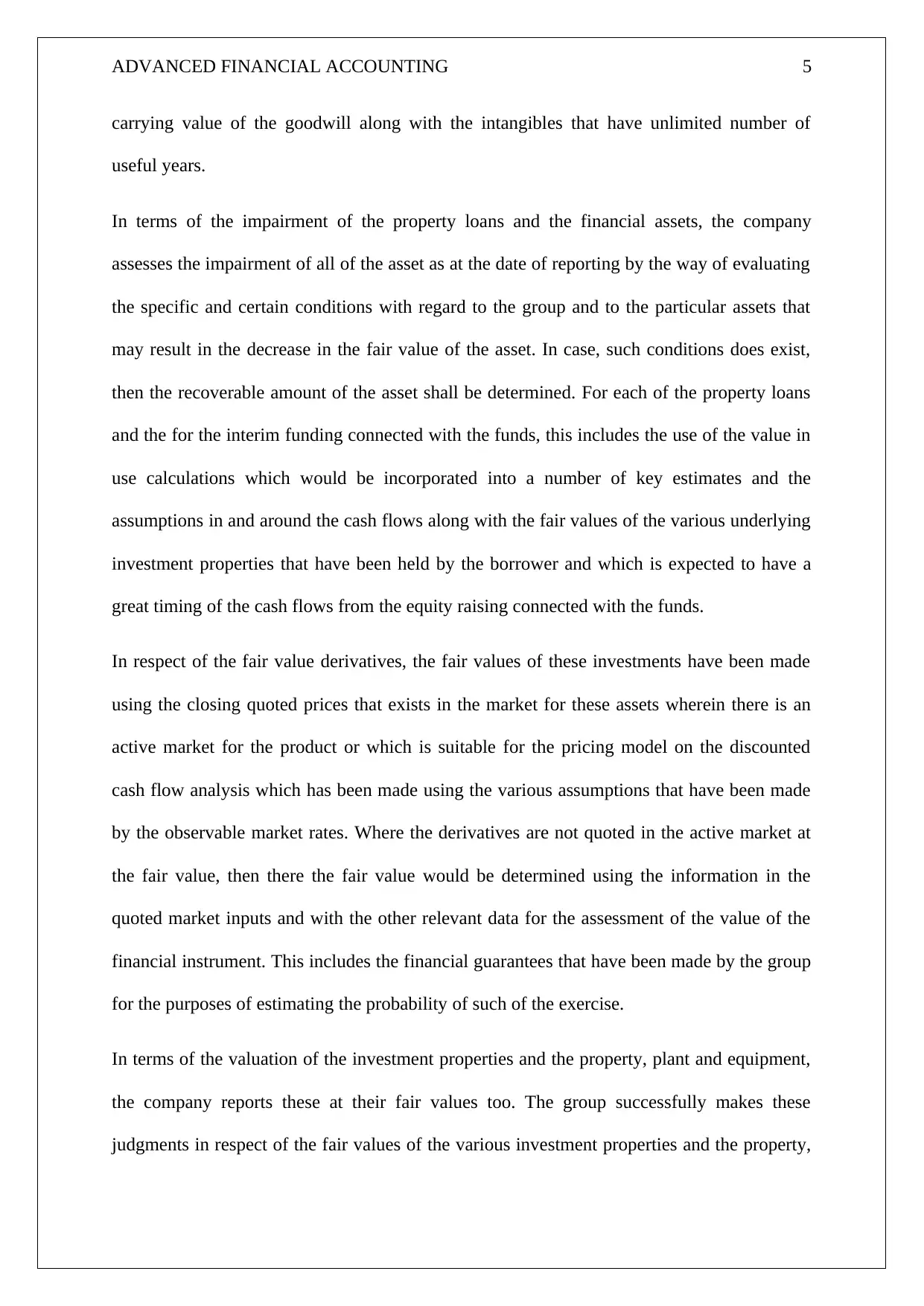
ADVANCED FINANCIAL ACCOUNTING 5
carrying value of the goodwill along with the intangibles that have unlimited number of
useful years.
In terms of the impairment of the property loans and the financial assets, the company
assesses the impairment of all of the asset as at the date of reporting by the way of evaluating
the specific and certain conditions with regard to the group and to the particular assets that
may result in the decrease in the fair value of the asset. In case, such conditions does exist,
then the recoverable amount of the asset shall be determined. For each of the property loans
and the for the interim funding connected with the funds, this includes the use of the value in
use calculations which would be incorporated into a number of key estimates and the
assumptions in and around the cash flows along with the fair values of the various underlying
investment properties that have been held by the borrower and which is expected to have a
great timing of the cash flows from the equity raising connected with the funds.
In respect of the fair value derivatives, the fair values of these investments have been made
using the closing quoted prices that exists in the market for these assets wherein there is an
active market for the product or which is suitable for the pricing model on the discounted
cash flow analysis which has been made using the various assumptions that have been made
by the observable market rates. Where the derivatives are not quoted in the active market at
the fair value, then there the fair value would be determined using the information in the
quoted market inputs and with the other relevant data for the assessment of the value of the
financial instrument. This includes the financial guarantees that have been made by the group
for the purposes of estimating the probability of such of the exercise.
In terms of the valuation of the investment properties and the property, plant and equipment,
the company reports these at their fair values too. The group successfully makes these
judgments in respect of the fair values of the various investment properties and the property,
carrying value of the goodwill along with the intangibles that have unlimited number of
useful years.
In terms of the impairment of the property loans and the financial assets, the company
assesses the impairment of all of the asset as at the date of reporting by the way of evaluating
the specific and certain conditions with regard to the group and to the particular assets that
may result in the decrease in the fair value of the asset. In case, such conditions does exist,
then the recoverable amount of the asset shall be determined. For each of the property loans
and the for the interim funding connected with the funds, this includes the use of the value in
use calculations which would be incorporated into a number of key estimates and the
assumptions in and around the cash flows along with the fair values of the various underlying
investment properties that have been held by the borrower and which is expected to have a
great timing of the cash flows from the equity raising connected with the funds.
In respect of the fair value derivatives, the fair values of these investments have been made
using the closing quoted prices that exists in the market for these assets wherein there is an
active market for the product or which is suitable for the pricing model on the discounted
cash flow analysis which has been made using the various assumptions that have been made
by the observable market rates. Where the derivatives are not quoted in the active market at
the fair value, then there the fair value would be determined using the information in the
quoted market inputs and with the other relevant data for the assessment of the value of the
financial instrument. This includes the financial guarantees that have been made by the group
for the purposes of estimating the probability of such of the exercise.
In terms of the valuation of the investment properties and the property, plant and equipment,
the company reports these at their fair values too. The group successfully makes these
judgments in respect of the fair values of the various investment properties and the property,
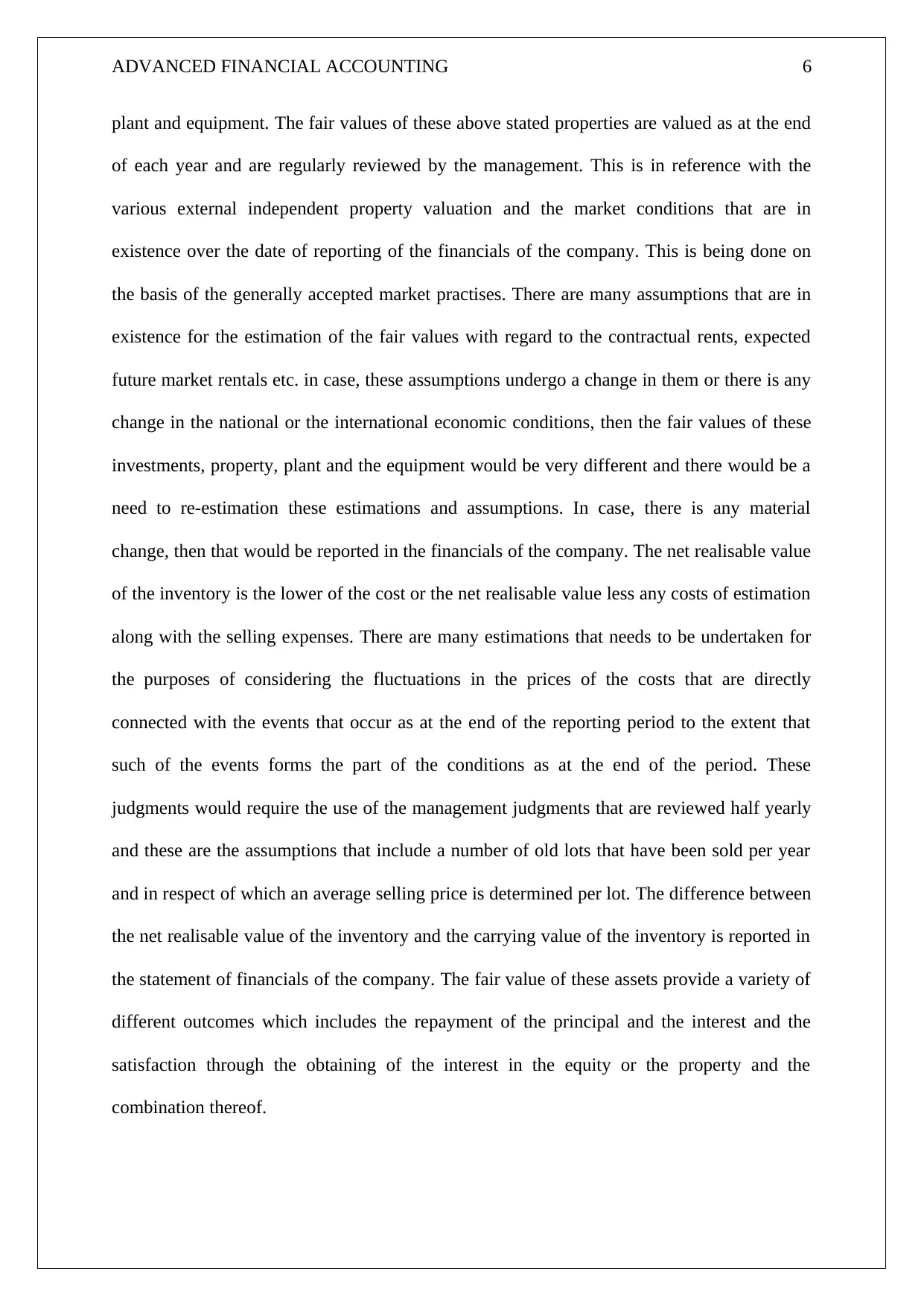
ADVANCED FINANCIAL ACCOUNTING 6
plant and equipment. The fair values of these above stated properties are valued as at the end
of each year and are regularly reviewed by the management. This is in reference with the
various external independent property valuation and the market conditions that are in
existence over the date of reporting of the financials of the company. This is being done on
the basis of the generally accepted market practises. There are many assumptions that are in
existence for the estimation of the fair values with regard to the contractual rents, expected
future market rentals etc. in case, these assumptions undergo a change in them or there is any
change in the national or the international economic conditions, then the fair values of these
investments, property, plant and the equipment would be very different and there would be a
need to re-estimation these estimations and assumptions. In case, there is any material
change, then that would be reported in the financials of the company. The net realisable value
of the inventory is the lower of the cost or the net realisable value less any costs of estimation
along with the selling expenses. There are many estimations that needs to be undertaken for
the purposes of considering the fluctuations in the prices of the costs that are directly
connected with the events that occur as at the end of the reporting period to the extent that
such of the events forms the part of the conditions as at the end of the period. These
judgments would require the use of the management judgments that are reviewed half yearly
and these are the assumptions that include a number of old lots that have been sold per year
and in respect of which an average selling price is determined per lot. The difference between
the net realisable value of the inventory and the carrying value of the inventory is reported in
the statement of financials of the company. The fair value of these assets provide a variety of
different outcomes which includes the repayment of the principal and the interest and the
satisfaction through the obtaining of the interest in the equity or the property and the
combination thereof.
plant and equipment. The fair values of these above stated properties are valued as at the end
of each year and are regularly reviewed by the management. This is in reference with the
various external independent property valuation and the market conditions that are in
existence over the date of reporting of the financials of the company. This is being done on
the basis of the generally accepted market practises. There are many assumptions that are in
existence for the estimation of the fair values with regard to the contractual rents, expected
future market rentals etc. in case, these assumptions undergo a change in them or there is any
change in the national or the international economic conditions, then the fair values of these
investments, property, plant and the equipment would be very different and there would be a
need to re-estimation these estimations and assumptions. In case, there is any material
change, then that would be reported in the financials of the company. The net realisable value
of the inventory is the lower of the cost or the net realisable value less any costs of estimation
along with the selling expenses. There are many estimations that needs to be undertaken for
the purposes of considering the fluctuations in the prices of the costs that are directly
connected with the events that occur as at the end of the reporting period to the extent that
such of the events forms the part of the conditions as at the end of the period. These
judgments would require the use of the management judgments that are reviewed half yearly
and these are the assumptions that include a number of old lots that have been sold per year
and in respect of which an average selling price is determined per lot. The difference between
the net realisable value of the inventory and the carrying value of the inventory is reported in
the statement of financials of the company. The fair value of these assets provide a variety of
different outcomes which includes the repayment of the principal and the interest and the
satisfaction through the obtaining of the interest in the equity or the property and the
combination thereof.
⊘ This is a preview!⊘
Do you want full access?
Subscribe today to unlock all pages.

Trusted by 1+ million students worldwide
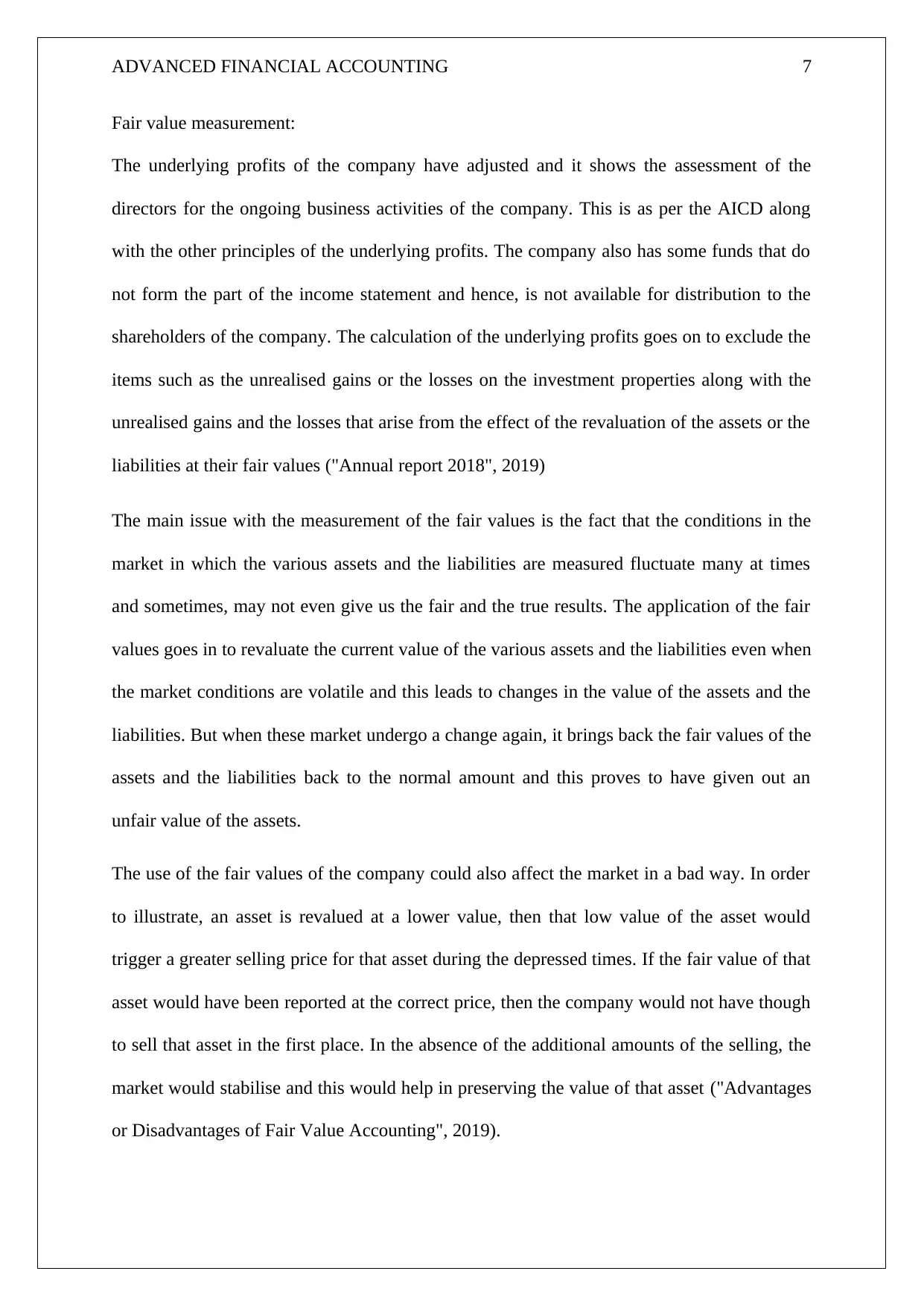
ADVANCED FINANCIAL ACCOUNTING 7
Fair value measurement:
The underlying profits of the company have adjusted and it shows the assessment of the
directors for the ongoing business activities of the company. This is as per the AICD along
with the other principles of the underlying profits. The company also has some funds that do
not form the part of the income statement and hence, is not available for distribution to the
shareholders of the company. The calculation of the underlying profits goes on to exclude the
items such as the unrealised gains or the losses on the investment properties along with the
unrealised gains and the losses that arise from the effect of the revaluation of the assets or the
liabilities at their fair values ("Annual report 2018", 2019)
The main issue with the measurement of the fair values is the fact that the conditions in the
market in which the various assets and the liabilities are measured fluctuate many at times
and sometimes, may not even give us the fair and the true results. The application of the fair
values goes in to revaluate the current value of the various assets and the liabilities even when
the market conditions are volatile and this leads to changes in the value of the assets and the
liabilities. But when these market undergo a change again, it brings back the fair values of the
assets and the liabilities back to the normal amount and this proves to have given out an
unfair value of the assets.
The use of the fair values of the company could also affect the market in a bad way. In order
to illustrate, an asset is revalued at a lower value, then that low value of the asset would
trigger a greater selling price for that asset during the depressed times. If the fair value of that
asset would have been reported at the correct price, then the company would not have though
to sell that asset in the first place. In the absence of the additional amounts of the selling, the
market would stabilise and this would help in preserving the value of that asset ("Advantages
or Disadvantages of Fair Value Accounting", 2019).
Fair value measurement:
The underlying profits of the company have adjusted and it shows the assessment of the
directors for the ongoing business activities of the company. This is as per the AICD along
with the other principles of the underlying profits. The company also has some funds that do
not form the part of the income statement and hence, is not available for distribution to the
shareholders of the company. The calculation of the underlying profits goes on to exclude the
items such as the unrealised gains or the losses on the investment properties along with the
unrealised gains and the losses that arise from the effect of the revaluation of the assets or the
liabilities at their fair values ("Annual report 2018", 2019)
The main issue with the measurement of the fair values is the fact that the conditions in the
market in which the various assets and the liabilities are measured fluctuate many at times
and sometimes, may not even give us the fair and the true results. The application of the fair
values goes in to revaluate the current value of the various assets and the liabilities even when
the market conditions are volatile and this leads to changes in the value of the assets and the
liabilities. But when these market undergo a change again, it brings back the fair values of the
assets and the liabilities back to the normal amount and this proves to have given out an
unfair value of the assets.
The use of the fair values of the company could also affect the market in a bad way. In order
to illustrate, an asset is revalued at a lower value, then that low value of the asset would
trigger a greater selling price for that asset during the depressed times. If the fair value of that
asset would have been reported at the correct price, then the company would not have though
to sell that asset in the first place. In the absence of the additional amounts of the selling, the
market would stabilise and this would help in preserving the value of that asset ("Advantages
or Disadvantages of Fair Value Accounting", 2019).
Paraphrase This Document
Need a fresh take? Get an instant paraphrase of this document with our AI Paraphraser
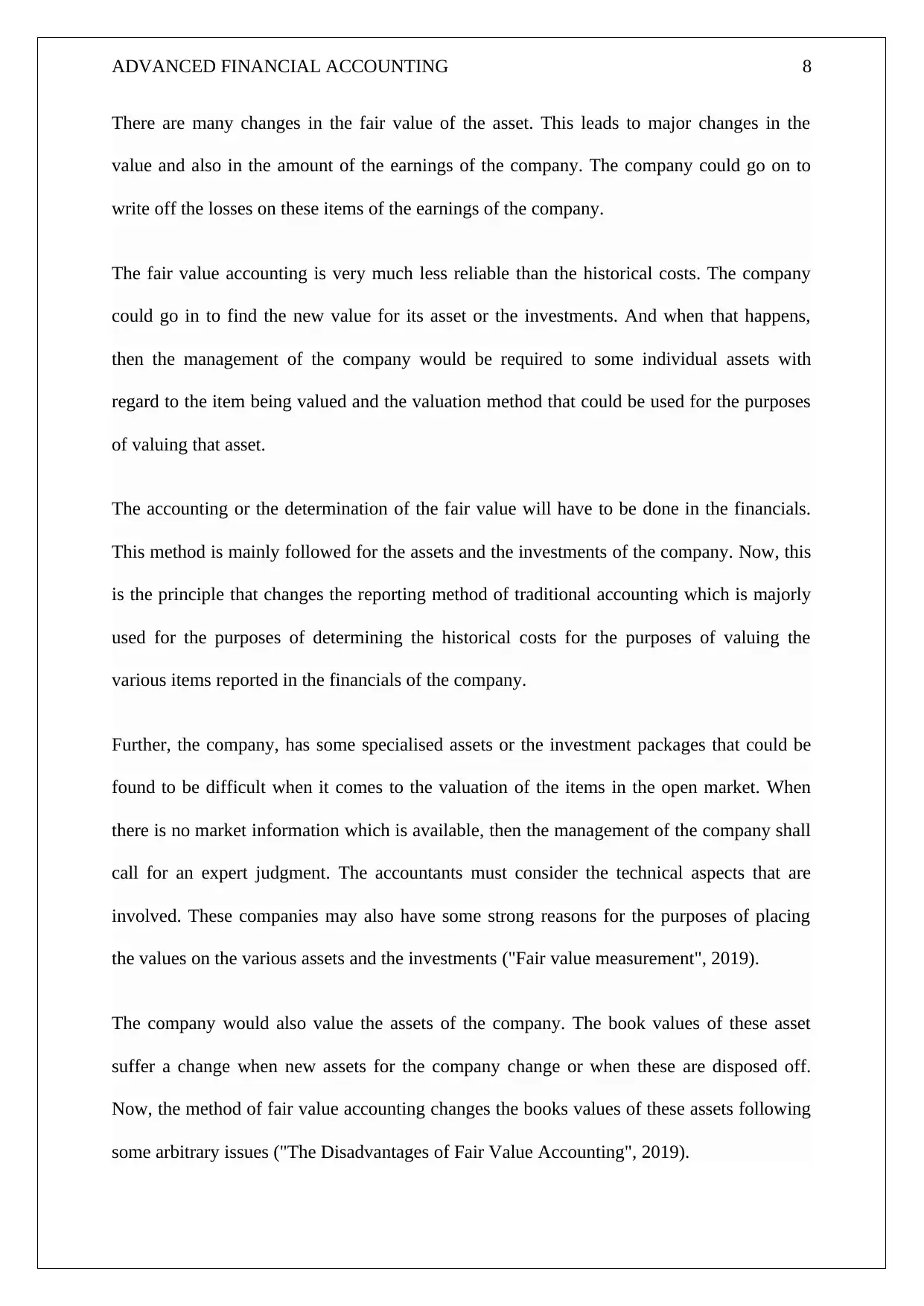
ADVANCED FINANCIAL ACCOUNTING 8
There are many changes in the fair value of the asset. This leads to major changes in the
value and also in the amount of the earnings of the company. The company could go on to
write off the losses on these items of the earnings of the company.
The fair value accounting is very much less reliable than the historical costs. The company
could go in to find the new value for its asset or the investments. And when that happens,
then the management of the company would be required to some individual assets with
regard to the item being valued and the valuation method that could be used for the purposes
of valuing that asset.
The accounting or the determination of the fair value will have to be done in the financials.
This method is mainly followed for the assets and the investments of the company. Now, this
is the principle that changes the reporting method of traditional accounting which is majorly
used for the purposes of determining the historical costs for the purposes of valuing the
various items reported in the financials of the company.
Further, the company, has some specialised assets or the investment packages that could be
found to be difficult when it comes to the valuation of the items in the open market. When
there is no market information which is available, then the management of the company shall
call for an expert judgment. The accountants must consider the technical aspects that are
involved. These companies may also have some strong reasons for the purposes of placing
the values on the various assets and the investments ("Fair value measurement", 2019).
The company would also value the assets of the company. The book values of these asset
suffer a change when new assets for the company change or when these are disposed off.
Now, the method of fair value accounting changes the books values of these assets following
some arbitrary issues ("The Disadvantages of Fair Value Accounting", 2019).
There are many changes in the fair value of the asset. This leads to major changes in the
value and also in the amount of the earnings of the company. The company could go on to
write off the losses on these items of the earnings of the company.
The fair value accounting is very much less reliable than the historical costs. The company
could go in to find the new value for its asset or the investments. And when that happens,
then the management of the company would be required to some individual assets with
regard to the item being valued and the valuation method that could be used for the purposes
of valuing that asset.
The accounting or the determination of the fair value will have to be done in the financials.
This method is mainly followed for the assets and the investments of the company. Now, this
is the principle that changes the reporting method of traditional accounting which is majorly
used for the purposes of determining the historical costs for the purposes of valuing the
various items reported in the financials of the company.
Further, the company, has some specialised assets or the investment packages that could be
found to be difficult when it comes to the valuation of the items in the open market. When
there is no market information which is available, then the management of the company shall
call for an expert judgment. The accountants must consider the technical aspects that are
involved. These companies may also have some strong reasons for the purposes of placing
the values on the various assets and the investments ("Fair value measurement", 2019).
The company would also value the assets of the company. The book values of these asset
suffer a change when new assets for the company change or when these are disposed off.
Now, the method of fair value accounting changes the books values of these assets following
some arbitrary issues ("The Disadvantages of Fair Value Accounting", 2019).
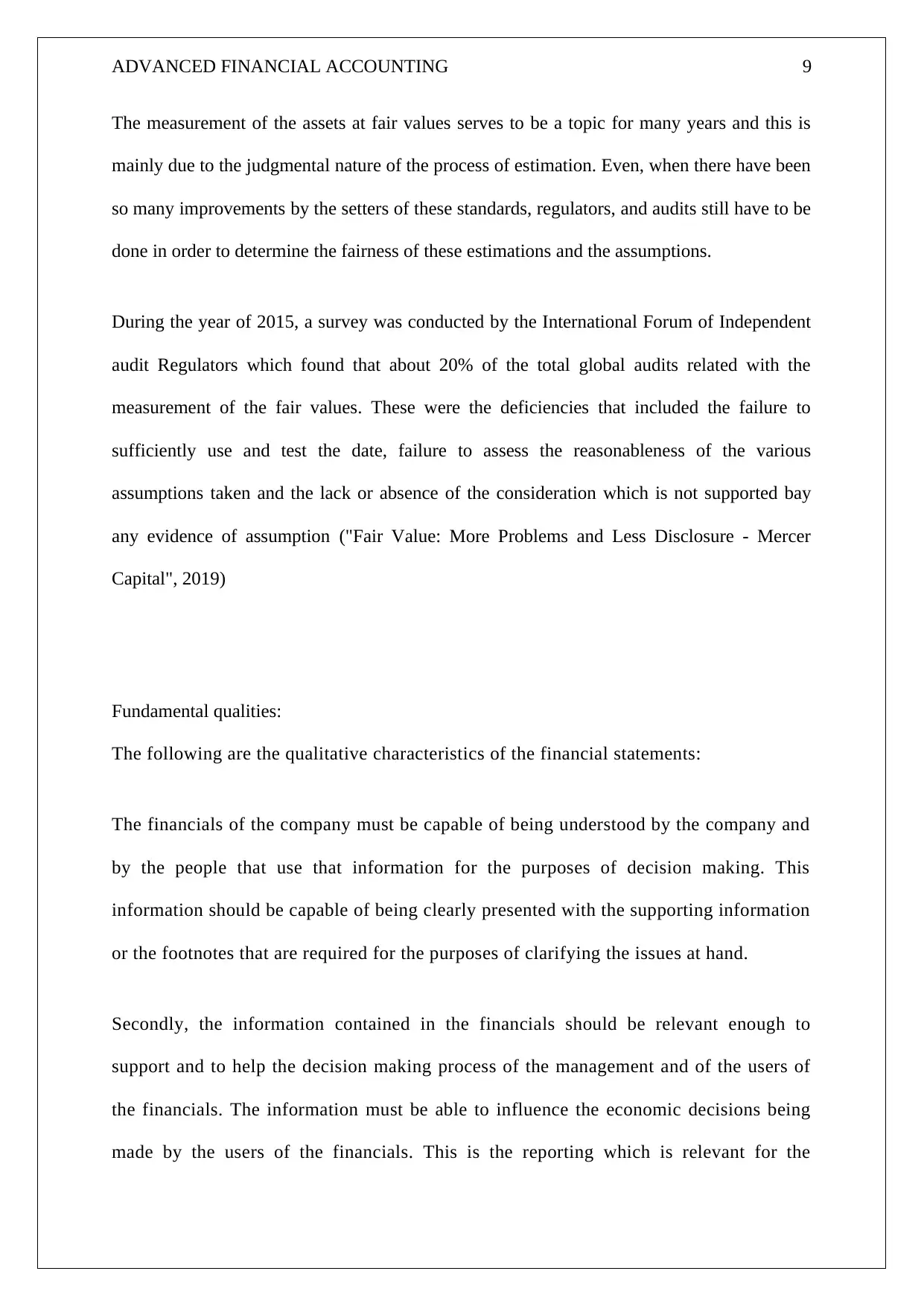
ADVANCED FINANCIAL ACCOUNTING 9
The measurement of the assets at fair values serves to be a topic for many years and this is
mainly due to the judgmental nature of the process of estimation. Even, when there have been
so many improvements by the setters of these standards, regulators, and audits still have to be
done in order to determine the fairness of these estimations and the assumptions.
During the year of 2015, a survey was conducted by the International Forum of Independent
audit Regulators which found that about 20% of the total global audits related with the
measurement of the fair values. These were the deficiencies that included the failure to
sufficiently use and test the date, failure to assess the reasonableness of the various
assumptions taken and the lack or absence of the consideration which is not supported bay
any evidence of assumption ("Fair Value: More Problems and Less Disclosure - Mercer
Capital", 2019)
Fundamental qualities:
The following are the qualitative characteristics of the financial statements:
The financials of the company must be capable of being understood by the company and
by the people that use that information for the purposes of decision making. This
information should be capable of being clearly presented with the supporting information
or the footnotes that are required for the purposes of clarifying the issues at hand.
Secondly, the information contained in the financials should be relevant enough to
support and to help the decision making process of the management and of the users of
the financials. The information must be able to influence the economic decisions being
made by the users of the financials. This is the reporting which is relevant for the
The measurement of the assets at fair values serves to be a topic for many years and this is
mainly due to the judgmental nature of the process of estimation. Even, when there have been
so many improvements by the setters of these standards, regulators, and audits still have to be
done in order to determine the fairness of these estimations and the assumptions.
During the year of 2015, a survey was conducted by the International Forum of Independent
audit Regulators which found that about 20% of the total global audits related with the
measurement of the fair values. These were the deficiencies that included the failure to
sufficiently use and test the date, failure to assess the reasonableness of the various
assumptions taken and the lack or absence of the consideration which is not supported bay
any evidence of assumption ("Fair Value: More Problems and Less Disclosure - Mercer
Capital", 2019)
Fundamental qualities:
The following are the qualitative characteristics of the financial statements:
The financials of the company must be capable of being understood by the company and
by the people that use that information for the purposes of decision making. This
information should be capable of being clearly presented with the supporting information
or the footnotes that are required for the purposes of clarifying the issues at hand.
Secondly, the information contained in the financials should be relevant enough to
support and to help the decision making process of the management and of the users of
the financials. The information must be able to influence the economic decisions being
made by the users of the financials. This is the reporting which is relevant for the
⊘ This is a preview!⊘
Do you want full access?
Subscribe today to unlock all pages.

Trusted by 1+ million students worldwide
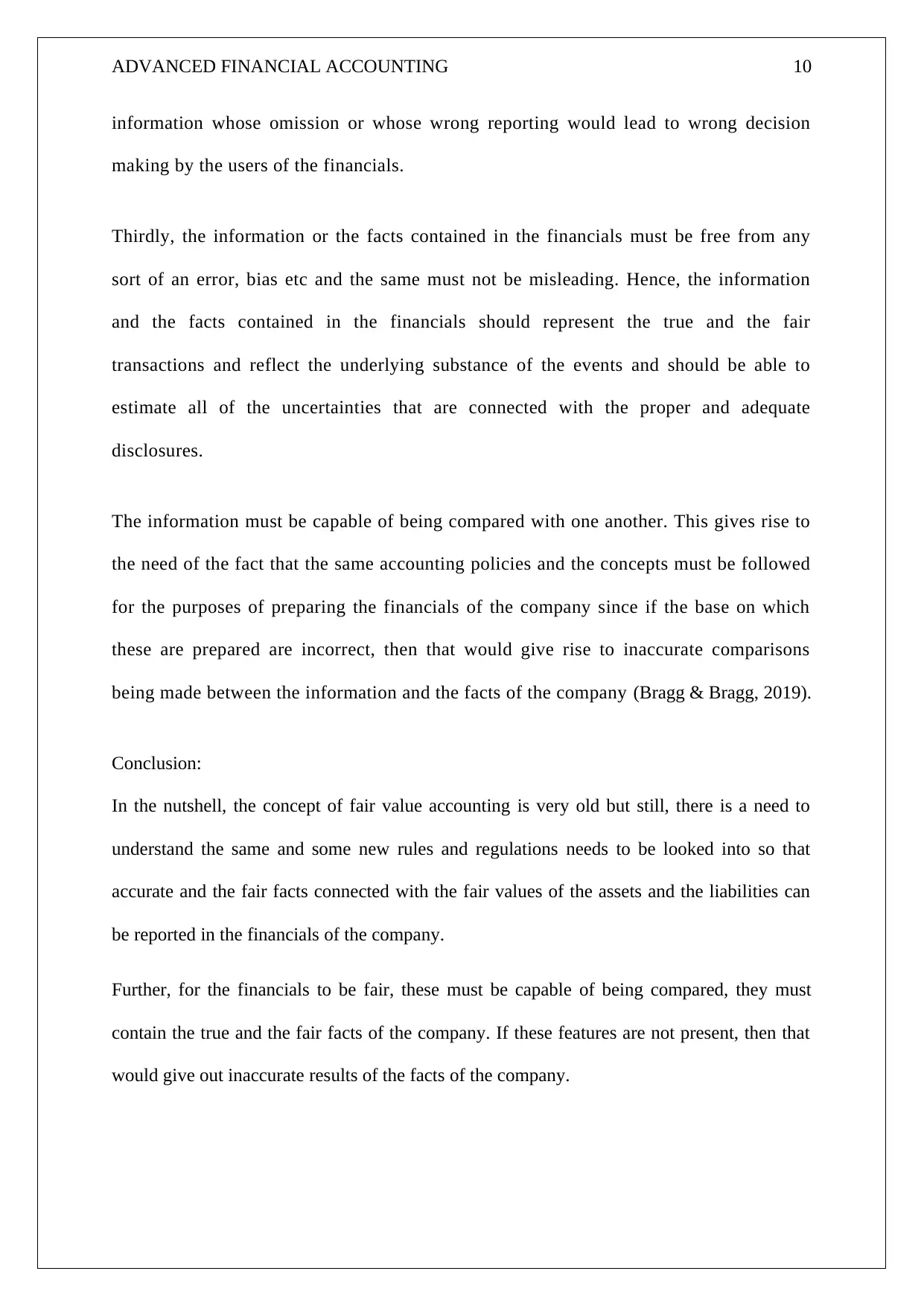
ADVANCED FINANCIAL ACCOUNTING 10
information whose omission or whose wrong reporting would lead to wrong decision
making by the users of the financials.
Thirdly, the information or the facts contained in the financials must be free from any
sort of an error, bias etc and the same must not be misleading. Hence, the information
and the facts contained in the financials should represent the true and the fair
transactions and reflect the underlying substance of the events and should be able to
estimate all of the uncertainties that are connected with the proper and adequate
disclosures.
The information must be capable of being compared with one another. This gives rise to
the need of the fact that the same accounting policies and the concepts must be followed
for the purposes of preparing the financials of the company since if the base on which
these are prepared are incorrect, then that would give rise to inaccurate comparisons
being made between the information and the facts of the company (Bragg & Bragg, 2019).
Conclusion:
In the nutshell, the concept of fair value accounting is very old but still, there is a need to
understand the same and some new rules and regulations needs to be looked into so that
accurate and the fair facts connected with the fair values of the assets and the liabilities can
be reported in the financials of the company.
Further, for the financials to be fair, these must be capable of being compared, they must
contain the true and the fair facts of the company. If these features are not present, then that
would give out inaccurate results of the facts of the company.
information whose omission or whose wrong reporting would lead to wrong decision
making by the users of the financials.
Thirdly, the information or the facts contained in the financials must be free from any
sort of an error, bias etc and the same must not be misleading. Hence, the information
and the facts contained in the financials should represent the true and the fair
transactions and reflect the underlying substance of the events and should be able to
estimate all of the uncertainties that are connected with the proper and adequate
disclosures.
The information must be capable of being compared with one another. This gives rise to
the need of the fact that the same accounting policies and the concepts must be followed
for the purposes of preparing the financials of the company since if the base on which
these are prepared are incorrect, then that would give rise to inaccurate comparisons
being made between the information and the facts of the company (Bragg & Bragg, 2019).
Conclusion:
In the nutshell, the concept of fair value accounting is very old but still, there is a need to
understand the same and some new rules and regulations needs to be looked into so that
accurate and the fair facts connected with the fair values of the assets and the liabilities can
be reported in the financials of the company.
Further, for the financials to be fair, these must be capable of being compared, they must
contain the true and the fair facts of the company. If these features are not present, then that
would give out inaccurate results of the facts of the company.
Paraphrase This Document
Need a fresh take? Get an instant paraphrase of this document with our AI Paraphraser
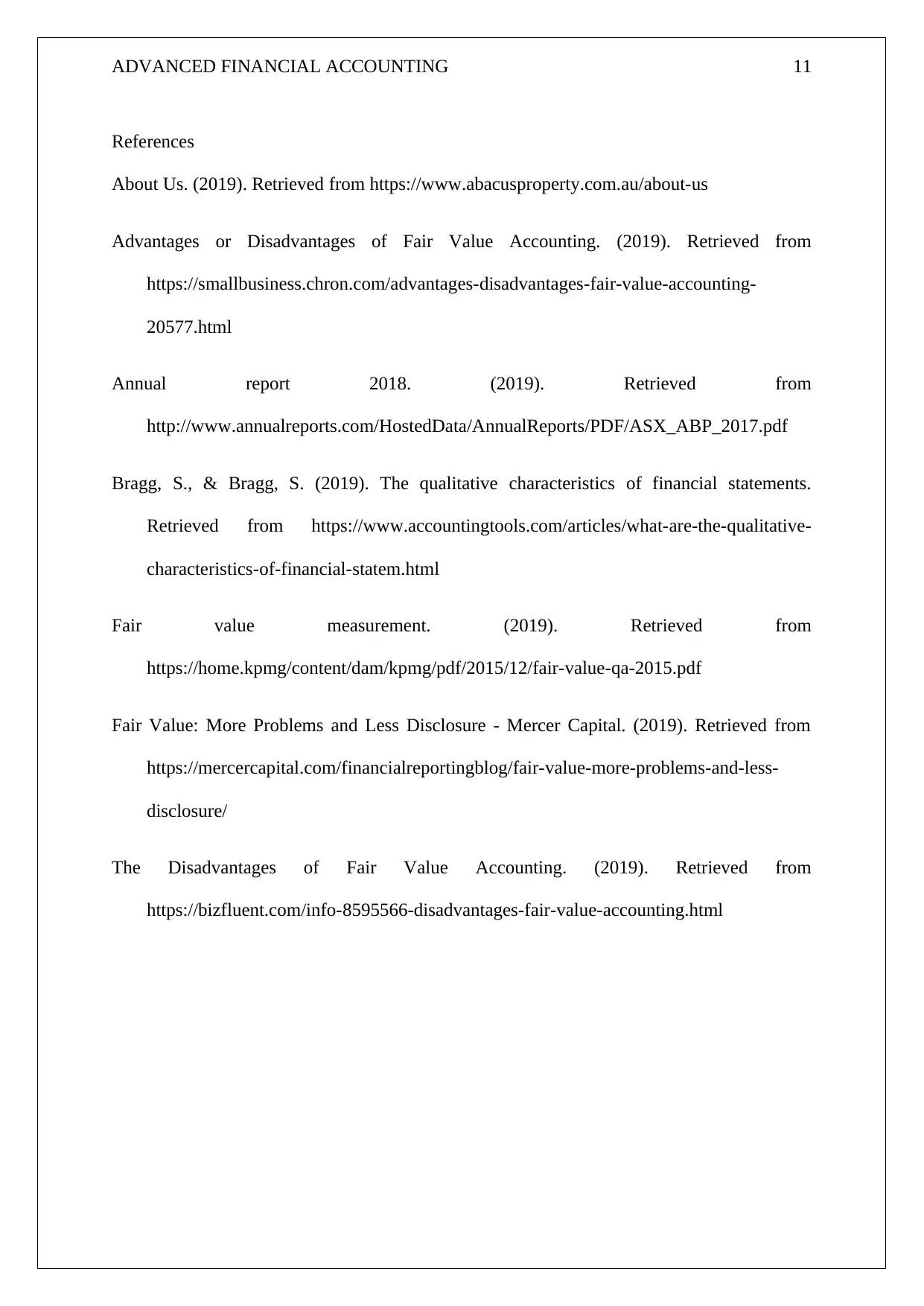
ADVANCED FINANCIAL ACCOUNTING 11
References
About Us. (2019). Retrieved from https://www.abacusproperty.com.au/about-us
Advantages or Disadvantages of Fair Value Accounting. (2019). Retrieved from
https://smallbusiness.chron.com/advantages-disadvantages-fair-value-accounting-
20577.html
Annual report 2018. (2019). Retrieved from
http://www.annualreports.com/HostedData/AnnualReports/PDF/ASX_ABP_2017.pdf
Bragg, S., & Bragg, S. (2019). The qualitative characteristics of financial statements.
Retrieved from https://www.accountingtools.com/articles/what-are-the-qualitative-
characteristics-of-financial-statem.html
Fair value measurement. (2019). Retrieved from
https://home.kpmg/content/dam/kpmg/pdf/2015/12/fair-value-qa-2015.pdf
Fair Value: More Problems and Less Disclosure - Mercer Capital. (2019). Retrieved from
https://mercercapital.com/financialreportingblog/fair-value-more-problems-and-less-
disclosure/
The Disadvantages of Fair Value Accounting. (2019). Retrieved from
https://bizfluent.com/info-8595566-disadvantages-fair-value-accounting.html
References
About Us. (2019). Retrieved from https://www.abacusproperty.com.au/about-us
Advantages or Disadvantages of Fair Value Accounting. (2019). Retrieved from
https://smallbusiness.chron.com/advantages-disadvantages-fair-value-accounting-
20577.html
Annual report 2018. (2019). Retrieved from
http://www.annualreports.com/HostedData/AnnualReports/PDF/ASX_ABP_2017.pdf
Bragg, S., & Bragg, S. (2019). The qualitative characteristics of financial statements.
Retrieved from https://www.accountingtools.com/articles/what-are-the-qualitative-
characteristics-of-financial-statem.html
Fair value measurement. (2019). Retrieved from
https://home.kpmg/content/dam/kpmg/pdf/2015/12/fair-value-qa-2015.pdf
Fair Value: More Problems and Less Disclosure - Mercer Capital. (2019). Retrieved from
https://mercercapital.com/financialreportingblog/fair-value-more-problems-and-less-
disclosure/
The Disadvantages of Fair Value Accounting. (2019). Retrieved from
https://bizfluent.com/info-8595566-disadvantages-fair-value-accounting.html
1 out of 11
Related Documents
Your All-in-One AI-Powered Toolkit for Academic Success.
+13062052269
info@desklib.com
Available 24*7 on WhatsApp / Email
![[object Object]](/_next/static/media/star-bottom.7253800d.svg)
Unlock your academic potential
Copyright © 2020–2025 A2Z Services. All Rights Reserved. Developed and managed by ZUCOL.





